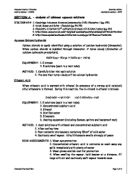--- for controlling solution pH for chemical / biochemical reactions,
--- for preserving food
(e) their importance in nature
--- maintenance of blood pH
__________________________________________________________________________
~ Sample Essay ~
A buffer solution is one which resists changes in pH when small amounts of acid or alkali is added to it. It plays an important role in chemical processes where it is essential that a fairly constant pH is maintained. Buffer solutions could be classified into two types, namely acidic buffer and basic buffer solutions.
Acidic buffer solutions
An acidic buffer solution is one which has a pH less than 7. They are commonly made from a weak acid and its sodium salt. A mixture of ethanoic acid and sodium ethanoate solutions is a typical example. pH of buffer solutions could be adjusted by changing the ratio f acid and salt, or by choosing a different acid and its salt.
Ethanoic acid is a weak acid, and the equilibrium position will be well to the left:
CH3COOH + H2O CH3COO- + H3O+ (eqn. 1)
Adding sodium ethanoate to this ethanoic acid solution will shift the equilibrium position even further to the left, in accordance to Le Chatelier Principle.
If a small amount of strong acid such as HCl is added to this buffer, most of the added hydroxonium ions are removed by ethanoate ions to form ethanoic acid. Since ethanoic acid is a weak acid, the equilibrium is well to the right:
CH3COO- + H3O+ CH3COOH + H2O (eqn. 2)
In this way, most of the hydroxonium ions are removed by ethanoate ions, and thus the pH of solution is not altered to a great degree.
When a strong base such as NaOH is added to the buffer, there are two processes which can remove hydroxide ions. Firstly, the ethanoic acid reacts with it and consumes the excess OH- ions:
CH3COOH + OH- CH3COO- + H2O (eqn. 3)
On the other hand, the hydroxide ions combine with the hydroxonium ions furnished by ethanoic acid (see eqn. 1) to form water. As soon as this happens, the equilibrium of eqn. 1 is disturbed and then it shifts to the right so as to replace the H3O+ in order to restore the equilibrium. This keeps on happening until most of the incoming OH- are removed, and the pH remains almost constant.
Basic buffer solutions
A basic buffer solution is one which has a pH higher than 7. They are commonly made from a weak alkali and its salt. A mixture of ammonia and ammonium chloride solutions is a typical example.
Ammonia is a weak base, and the equilibrium position will be well to the left:
NH3 + H2O NH4+ + OH- (eqn. 4)
Adding ammonium chloride to this ammonia solution will shift the equilibrium position even further to the left, in accordance to Le Chatelier Principle.
When a strong acid such as HCl is added to the buffer, there are two processes which can remove hydroxonium ions. Firstly, the ammonia reacts with it and consumes the excess H3O+ ions:
NH3 + H3O+ NH4+ + H2O (eqn. 5)
On the other hand, the hydroxonium ions combine with the hydroxide ions produced by ammonia (see eqn. 4) to form water. As soon as this happens, the equilibrium of eqn. 4 shifts to the right so as to replace the OH-. This keeps on happening until most of the incoming H3O+ are removed, and the pH doesn’t increase very much.
When a strong alkali is added to this buffer, the incoming hydroxide ions are removed by a simple reaction with ammonium ions:
NH4+ + OH- NH3 + H2O (eqn. 6)
In this way, most of the hydroxide ions are removed from the solution, and thus the pH of solution will not change very much.
Applications and Importance in Nature
In laboratory, buffer solutions are useful in preparing solution of a known and constant pH for checking the indicators and calibrating pH meters. They are also used to control pH solutions which involve chemical and biochemical reactions. Furthermore, buffers are also used in the preservatives to limit the acidity of food.
In a good many of industrial and physiological processes, specific reactions occur at some optimum pH values. When the pH varies to any extent from the optimum value, undesirable reactions and effects may occur.
For example, the pH of your blood lies at about 7.35. If this value drops below or rises above 7.0, the results are fatal. Fortunately our blood contains a buffering system which maintains the acidity at the proper level. The molecule of plasma proteins act as buffers as they bear both the carboxylic acid group (–COOH) and the basic amino group (–NH2).
H2O + CO2 H2CO3 H+ + HCO3- (eqn. 7)
The protein acts as a base, and thereby neutralizing the additional H+ ions formed at high concentration of CO2. Meanwhile, it can also function as an acid to remove the additional HCO3- ions. Hence, a fairly constant pH of blood is maintained.
In conclusion, a solution of stable pH is always important in many chemical and biochemical processes, in which buffer solution undoubtedly plays an active role. Particularly, buffer solutions are important to human body: without the protection of the buffering system in our bodies, we could not eat and adsorb many of the acidic fruit juices and foods in our diet!









